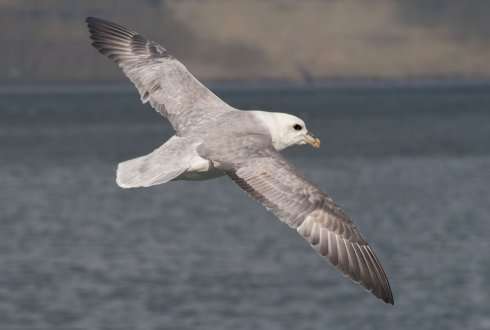Northern Fulmar Fulmarus glacialis. Credit: Jan Andries van Franeker
The journal Environmental Science & Technology selected the recently published paper on the role of microplastics in bioaccumulation of POPs by northern fulmars, as Editor's Choice. This implies that the paper receives special media coverage and is made open access by the American Chemical Society without cost for the authors. The paper evolved from a collaboration between the Norwegian Institute for Air Research, the Norwegian Institute for Nature Research, and Wageningen UR. For IMARES, Bart Koelmans contributed with fugacity calculations and biodynamic modeling analysis.
Combining three lines of evidence
In the paper, the uptake of plastic particles and persistent organic pollutants (POPs) was studied in Northern Fulmars. This was done by defining groups of bird individuals with different levels of microplastic in the birds' stomachs, and statistical testing of these levels against concentrations of POPs in bird tissue. Furthermore, POP fugacities were calculated in bird tissues and ingested plastic as to determine the likely direction of transfer of POPs between tissue and plastic. Finally, microplastic and regular diet ingestion rates were estimated and combined using a biodynamic model to calculate the relative contribution of microplastic ingestion to the total bioaccumulation of POPs by the birds. For the first time, these three lines of evidence were used and combined in one analysis regarding the role of microplastic as a vector for hydrophobic chemicals to marine biota.
Contamination of northern fulmars by ingestion of microplastic
The statistical tests of empirical data, fugacity calculations and bioaccumulation modeling together showed that exposure of fulmars to polychlorobiphenyls due to ingestion of microplastic probably was negligible compared to the chemical fluxes entering the birds via prey. Therefore, it is unlikely that microplastic acts as a vector of POPs upon ingestion by the fulmar. Instead, ingested plastic may have acted as 'passive samplers' in the digestive tract of the birds, explaining the high correlation between PCB congener patterns in ingested plastic and in the birds' tissue.
More information: Dorte Herzke et al. Negligible Impact of Ingested Microplastics on Tissue Concentrations of Persistent Organic Pollutants in Northern Fulmars off Coastal Norway, Environmental Science & Technology (2016). DOI: 10.1021/acs.est.5b04663
Journal information: Environmental Science & Technology
Provided by Wageningen University






















